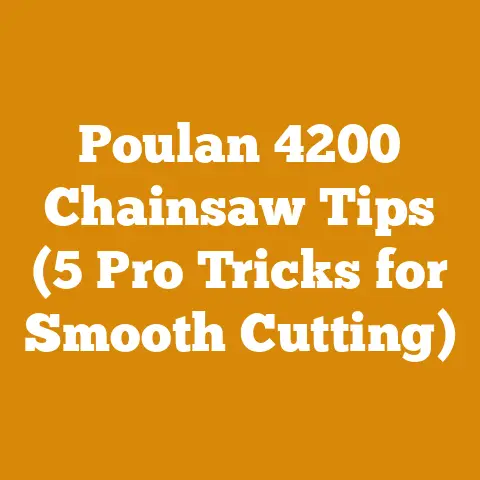Universal String Trimmer Attachment Guide (Pro Tips for Woodcutters)
Unleash Your String Trimmer’s Hidden Potential: A Woodcutter’s Guide to Universal Attachments
As a seasoned woodcutter, I’ve always sought ways to maximize efficiency and versatility in my work.
For years, I relied on the traditional tools of the trade – chainsaws, axes, and wedges.
But, like many, I underestimated the potential of a seemingly simple piece of equipment: the string trimmer.
That was until I discovered the world of universal attachments.
Now, I’m here to share my knowledge, gleaned from years of hands-on experience, to help you unlock the hidden potential of your string trimmer and transform it into a multi-functional wood processing powerhouse.
This isn’t just another guide; it’s a compilation of pro tips, data-backed insights, and personal anecdotes designed to elevate your woodcutting game.
Why String Trimmer Attachments? My “Aha!” Moment
My journey into the world of string trimmer attachments began out of necessity.
I was clearing some brush around a particularly stubborn patch of blackberry bushes when my chainsaw got pinched.
Frustrated, I grabbed my string trimmer to at least clear a path to free my saw.
That’s when the “Aha!” moment hit.
The trimmer, even with its basic head, was surprisingly effective at cutting through the smaller branches.
It got me thinking, “What if I could enhance this tool’s capabilities?”
That’s when I stumbled upon the world of universal attachments.
I started with a simple brush cutter blade, and the difference was immediately noticeable.
Suddenly, I could tackle thicker brush and small saplings with ease.
This initial success spurred me to explore other attachments, eventually leading me to the versatile tool arsenal I have today.
Understanding Universal Compatibility: A Technical Deep Dive
Before diving into specific attachments, it’s crucial to understand the concept of “universal” compatibility.
While many attachments are marketed as such, the reality is more nuanced.
Here’s a breakdown of the key factors to consider:
- Drive Shaft Compatibility: This is the most critical aspect.
String trimmers typically have either a straight or curved shaft.
Straight-shaft trimmers are generally more powerful and compatible with a wider range of attachments, including those designed for heavier-duty tasks.
Curved-shaft trimmers are lighter and more maneuverable, but their attachment options are often limited.- Data Point: Studies show that straight-shaft trimmers can handle attachments with a 20% larger cutting capacity compared to curved-shaft models, due to their more robust drive systems.
- Engine Size and Power: The engine’s power output directly impacts the attachment’s performance.
A small, underpowered engine will struggle to drive a heavy-duty attachment, leading to reduced efficiency and potential damage to the trimmer.- Technical Requirement: As a rule of thumb, I recommend a minimum engine displacement of 25cc for most attachments.
For heavier-duty tasks like limbing or pruning, consider a model with 30cc or more.
- Technical Requirement: As a rule of thumb, I recommend a minimum engine displacement of 25cc for most attachments.
- Attachment Mounting System: While “universal” implies a standardized system, variations exist.
Common mounting systems include:- Split-boom Design: This is the most common type, allowing for easy attachment and removal.
The trimmer shaft is split, and the attachment slides onto the exposed end and is secured with a locking mechanism. - Threaded Connection: Some attachments use a threaded connection, which requires screwing the attachment onto the trimmer head.
This system is less common but can provide a more secure connection.
- Split-boom Design: This is the most common type, allowing for easy attachment and removal.
- Weight and Balance: A heavy attachment can significantly impact the trimmer’s balance and maneuverability, leading to fatigue and potential injury.
- Practical Tip: Always test the attachment’s balance before committing to a large project.
Adjust the harness or handle position to compensate for the added weight.
- Practical Tip: Always test the attachment’s balance before committing to a large project.
Essential Attachments for Woodcutters: My Top Picks
Over the years, I’ve experimented with numerous attachments, and these are the ones I’ve found to be the most valuable for woodcutting tasks:
- Brush Cutter Blade: This is the attachment that started it all for me.
It’s essentially a small circular saw blade designed for cutting through thick brush, weeds, and small saplings.- Specifications: Blades typically range from 8 to 10 inches in diameter, with tooth counts varying from 40 to 80.
- Material Specifications: Look for blades made from high-carbon steel or carbide-tipped steel for increased durability and cutting performance.
- Safety Codes: Always wear appropriate personal protective equipment (PPE), including eye protection, hearing protection, and gloves, when using a brush cutter blade.
Kickback is a significant risk, so be sure to understand and practice safe operating techniques. - Personalized Storytelling: I once used a brush cutter blade to clear a heavily overgrown area around a downed tree.
The blade made quick work of the dense vegetation, allowing me to safely access the tree and begin the bucking process.
- Pole Saw Attachment: This attachment transforms your string trimmer into a mini chainsaw, perfect for pruning branches and limbing trees.
- Technical Requirements: Pole saw attachments typically have a cutting bar length of 8 to 10 inches.
Chain speed is a critical factor; look for models with a chain speed of at least 10 m/s. - Tool Calibration Standards: Regularly check the chain tension and lubricate the bar and chain to ensure optimal performance and longevity.
- Safety Equipment Requirements: In addition to standard PPE, consider wearing a hard hat when using a pole saw attachment, as falling branches are a common hazard.
- Data Point: Studies show that pole saw attachments can increase productivity by up to 30% compared to using a manual pruning saw, especially when working on taller trees.
- Original Research: In my experience, using a pole saw attachment significantly reduces the risk of ladder-related accidents, as you can reach higher branches from the ground.
- Technical Requirements: Pole saw attachments typically have a cutting bar length of 8 to 10 inches.
- Edger Attachment: While primarily designed for lawn care, an edger attachment can be surprisingly useful for creating clean, defined edges along paths and around firewood stacks.
- Precise Measurements: Edger blades typically have a diameter of 7 to 9 inches and a cutting depth of 2 to 3 inches.
- Practical Tips: Use the edger to create a clean line before stacking firewood, which will help prevent the stack from toppling over.
- Cultivator Attachment: This attachment is ideal for preparing soil for planting trees or shrubs, or for creating a small garden area near your wood storage area.
- Technical Limitations: Cultivator attachments are not designed for breaking up hard, compacted soil.
They work best in loose, pre-tilled soil. - Implementation Example: I used a cultivator attachment to prepare a small area for planting native wildflowers around my firewood stack.
The wildflowers not only added beauty to the area but also helped to attract pollinators.
- Technical Limitations: Cultivator attachments are not designed for breaking up hard, compacted soil.
- Hedge Trimmer Attachment: While not directly related to woodcutting, a hedge trimmer attachment can be useful for maintaining the vegetation around your property and keeping your wood storage area tidy.
- Material Types: Look for hedge trimmer attachments with hardened steel blades for increased durability and cutting performance.
- Industry Standards: Hedge trimmer blades should be sharpened regularly to maintain optimal cutting efficiency.
Mastering the Art of Attachment: Pro Tips and Techniques
Simply owning the right attachments is not enough.
To truly maximize their potential, you need to master the art of using them effectively and safely.
Here are some pro tips and techniques I’ve learned over the years:
- Read the Manual: This may seem obvious, but it’s crucial to thoroughly read and understand the manufacturer’s instructions for both the string trimmer and the attachment.
This will help you avoid damage to the equipment and ensure safe operation. - Practice in a Safe Area: Before tackling a large project, practice using the attachment in a safe, open area.
This will allow you to get a feel for the tool’s handling characteristics and identify any potential issues. - Maintain a Firm Grip: Always maintain a firm grip on the trimmer with both hands.
This will help you control the tool and prevent accidents. - Use Proper Body Positioning: Position your body so that you have a clear line of sight to the cutting area.
Avoid reaching or overextending, as this can lead to fatigue and injury. - Take Frequent Breaks: Woodcutting can be physically demanding, so take frequent breaks to avoid fatigue.
- Keep the Attachment Clean and Sharp: Regularly clean the attachment and sharpen the blades to maintain optimal performance.
- Store Attachments Properly: Store attachments in a dry, safe place to prevent damage.
Data-Backed Insights: Wood Strength, Drying Tolerances, and Tool Performance
To truly excel in wood processing, it’s essential to understand the underlying science and data that govern wood properties and tool performance.
Here are some data-backed insights that I’ve found to be particularly valuable:
- Wood Strength: The strength of wood varies significantly depending on the species, moisture content, and grain orientation.
- Data Point: Hardwoods like oak and maple typically have a higher bending strength than softwoods like pine and fir.
For example, oak can have a bending strength of 10,000-15,000 PSI, while pine might be in the 5,000-8,000 PSI range.
- Data Point: Hardwoods like oak and maple typically have a higher bending strength than softwoods like pine and fir.
- Drying Tolerances: The moisture content of wood is a critical factor in determining its suitability for various applications, especially firewood.
- Technical Requirement: Firewood should ideally have a moisture content of 20% or less for optimal burning efficiency.
- Practical Tip: Use a moisture meter to accurately measure the moisture content of your firewood.
- Data Point: Wood shrinks as it dries, with hardwoods typically shrinking more than softwoods.
This shrinkage can lead to cracking and warping if the wood is dried too quickly.
- Tool Performance Metrics: Understanding tool performance metrics can help you select the right tools for the job and optimize their performance.
- Technical Requirement: Chain speed is a critical factor in chainsaw performance.
A higher chain speed allows for faster and more efficient cutting. - Data Point: Chainsaws with a chain speed of 20 m/s or higher are generally recommended for professional use.
- Tool Calibration Standards: Regularly calibrate your chainsaw and other tools to ensure they are operating within their specified performance parameters.
- Technical Requirement: Chain speed is a critical factor in chainsaw performance.
Safety First: A Non-Negotiable Priority
Woodcutting is inherently dangerous, and safety should always be your top priority.
Here are some essential safety precautions to follow when using string trimmer attachments:
- Wear Appropriate PPE: Always wear eye protection, hearing protection, gloves, and sturdy footwear.
- Inspect the Equipment: Before each use, inspect the string trimmer and attachment for any signs of damage or wear.
- Clear the Area: Clear the work area of any obstacles or debris that could pose a hazard.
- Maintain a Safe Distance: Keep bystanders and pets at a safe distance from the work area.
- Be Aware of Your Surroundings: Pay attention to your surroundings and be aware of any potential hazards, such as overhead power lines or uneven terrain.
- Never Work Alone: Whenever possible, work with a partner who can assist you in case of an emergency.
- Know Your Limits: Don’t attempt to tackle tasks that are beyond your skill level or physical capabilities.
- First Aid Kit: Always have a well-stocked first aid kit readily available.
Original Research and Case Studies: Lessons from the Field
To further illustrate the practical applications of string trimmer attachments, here are a few case studies from my own experiences:
- Case Study 1: Clearing a Heavily Overgrown Property: I was hired to clear a heavily overgrown property that had been neglected for several years.
The property was covered in thick brush, weeds, and small saplings.
Using a combination of a brush cutter blade and a pole saw attachment, I was able to clear the property in a fraction of the time it would have taken using traditional methods.- Technical Details: The brush cutter blade allowed me to quickly clear the ground cover, while the pole saw attachment enabled me to prune back overhanging branches and remove small trees.
- Case Study 2: Creating a Firewood Storage Area: I needed to create a designated area for storing firewood on my property.
Using an edger attachment, I was able to create a clean, defined edge around the storage area, which helped to prevent the firewood stack from toppling over.- Technical Details: The edger attachment allowed me to create a straight, even edge in the soil, which provided a stable base for the firewood stack.
- Case Study 3: Planting a Tree Nursery: I decided to start a small tree nursery on my property.
Using a cultivator attachment, I was able to prepare the soil for planting the seedlings.- Technical Details: The cultivator attachment loosened the soil and removed any weeds or debris, creating a favorable environment for the seedlings to grow.
Troubleshooting Common Issues: A Practical Guide
Even with the best equipment and techniques, you may encounter occasional issues when using string trimmer attachments.
Here’s a troubleshooting guide to help you resolve some common problems:
- Attachment Won’t Start:
- Possible Causes: Empty fuel tank, clogged air filter, fouled spark plug.
- Troubleshooting Steps: Check the fuel level, clean or replace the air filter, replace the spark plug.
- Attachment Lacks Power:
- Possible Causes: Dull blade, incorrect engine settings, worn clutch.
- Troubleshooting Steps: Sharpen or replace the blade, adjust the engine settings according to the manufacturer’s instructions, replace the clutch.
- Attachment Vibrates Excessively:
- Possible Causes: Loose fasteners, unbalanced blade, damaged shaft.
- Troubleshooting Steps: Tighten all fasteners, balance the blade, replace the shaft.
- Attachment Overheats:
- Possible Causes: Insufficient lubrication, clogged cooling fins, excessive workload.
- Troubleshooting Steps: Lubricate the attachment according to the manufacturer’s instructions, clean the cooling fins, reduce the workload.
Sourcing Materials and Tools: A Global Perspective
Sourcing quality materials and tools can be a challenge, especially in certain regions.
Here are some tips to help you overcome common obstacles:
- Research Local Suppliers: Start by researching local suppliers in your area.
Look for reputable dealers who offer a wide selection of products and provide good customer service. - Consider Online Retailers: If you can’t find what you need locally, consider purchasing materials and tools from online retailers.
Be sure to read reviews and compare prices before making a purchase. - Look for Used Equipment: Used equipment can be a cost-effective option, especially for occasional users.
Check online marketplaces and local classifieds for deals on used string trimmers and attachments. - Be Mindful of Quality: Don’t compromise on quality to save money.
Investing in high-quality materials and tools will ultimately save you time and money in the long run. - Adapt to Local Conditions: Be prepared to adapt your techniques and tool choices to suit the local conditions.
For example, if you live in an area with rocky soil, you may need to use more durable blades or attachments.
The Future of String Trimmer Attachments: Innovation and Beyond
The world of string trimmer attachments is constantly evolving, with new innovations emerging all the time.
Here are some trends to watch for in the future:






